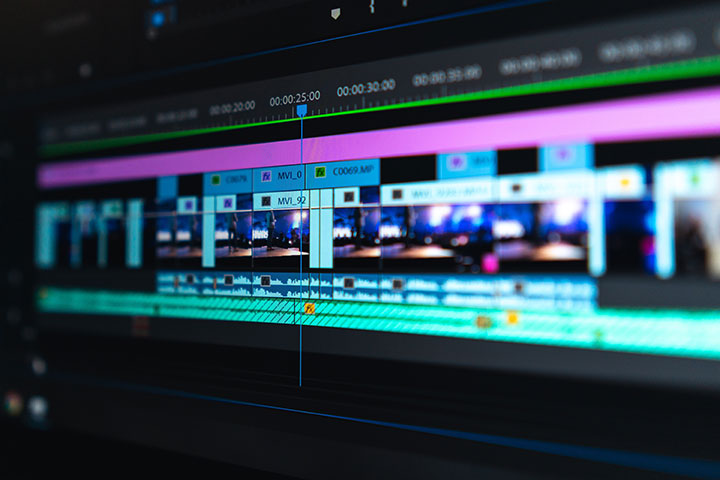Technology
1. Video Editing & Production
The manner in which knowledge and information is transferred is undergoing a major transformation. Electronic slide presentations were introduced to the general market in 1987 and voraciously utilized in education and business. Today, video presentations are becoming far more prevalent; being used for education, the news industry, marketing, product instruction, social publications, Enterprise Knowledge Management (EKM), etc.
Students will need to learn the basic concepts of video editing—including the canvas, timeline, layers, media assets & asset filetypes. Students will need proficiencies with moving assets along a timeline and manipulation of layers to achieve simple objectives. Finally, students will need an understanding of project export & sharing appropriate to various mediums.
2. Image Editing
As with video editing, images have become fundamental to nearly every industry—for education, historical record, marketing, instruction, etc. Students possessing proficiencies in image management will provide greater value to nearly every industry they engage.
Optimally, students should know the basic concepts of image properties such as lossless (i.e. .png), lossy (i.e. .jpg) and appropriate use and application for such filetypes.
Students should be familiar and have basic proficiencies with image editing including ability to capture and modify screenshots—which is important for training and educational endeavors, and to remove backgrounds—which is important for enterprise applications. Students should be able to degrade an image to meet file size constraints and to use images as video assets.
3. Website Development
The internet is an informational medium with immense power—and websites are the informational building blocks of the internet. With the low cost of domain acquisition, hosting, and public domain tools for website development, websites provide a very low barrier to entry for the plethora of missions they engage. Further, website information is available and accessible to the majority of the world’s population …every moment of every day.
Students require proficiencies with website development, deployment, maintenance to substantially benefit their own lives and entrepreneurial endeavors, as well as for the functionalities of the enterprises for which they will work.
Language & Communication
Development
4. Structured Conversation
A structured conversation is a technique for the transfer of specific informational elements, typically through a collaborative conversation.
The traditional modalities of communicative expression taught to students, such as essay, journalism, even debate, do not provide proficiency or literacy for structured conversation. Nearly every conversation has informational goals which should be anticipated—or derived real-time—in order to convey relevant and meaningful information.
Students need to learn the constructs and informational goals of collaborative conversation to more competently function in the enterprises to which they become employed, and for the conversations that will affect their personal lives—for example, as consumers of healthcare, technology, etc. Specifically, students should receive training and practice structured conversation in a variety of settings including as a patient seeking medical care, a consumer with a customer service problem, and as a participant in a business meeting with specific goals & objectives.
Health Education
5. Anxiety and Panic Disorders
One in five U.S. adults have been diagnosed with an anxiety disorder. Many are untreated, many are over-treated, and many are improperly treated. The cost of anxiety and depression on the U.S. economy is nearly $50 billion/year making it one of the costliest medical conditions in the country .
Students should be taught the pathophysiology of anxiety, specifically that anxiety is the product of a hormonal 'flight-or-fight' response which has developed through millions of years of biological evolution to help us survive. It is a natural process that can go awry, but generally can be controlled—and cured—with an understanding of the cause, and equipped with simple techniques to alleviate attacks.
6. Diabetes
Presently more than one in 10 U.S. adults are affected with diabetes, with yearly prevalences still increasing exponentially. This potentially debilitating disease serves as a major risk factor and gateway for other serious medical problems including blindness, renal failure, neuropathy, vascular ischemia/amputation, heart attack, stroke, etc.
Students require an understanding of the metabolism of sugar, the effects of hyperglycemia (high sugar), sources of sugar in the diet.
Diabetes is devastating to the individual and to society. Students must understand habits and lifestyles that can increase or decrease the risk of diabetes, and the methods and importance of management of diabetes to prevent further disease and complications.
Mathematics
7. Statistics
Our society has become increasing data driven. Data is mined from our communication, travel, and nearly every interaction we have with our portable electronic devices. Data is used in marketing, politics and—perhaps with greatest individual effect—in conveying the risks and benefits of pharmaceuticals. Statistics is a powerful mathematical tool for the interpretation and conveying of such data; sometimes it can be very helpful—and sometimes it is purposely used to be deceitful.
Students must be able to understand the value of statistical information beyond the simple assertations presented. Specifically, an understanding of percent-reduction vs. percent increase, relative risk reduction vs absolute risk reduction, and absolute risk are measures often utilized with intent to deceive an audience.
Science
8. Energetics
With the increasing world population, global energy needs and consumption will continue to grow. Furthermore, future communities will need to utilize other energy sources as human communities move to other environments including sea, orbit, space.
Students should have an understanding of macro-energetics with an appreciation of societal consumption (petajoules, megawatt) and the capacity of each of the available energy sources.
Students should understand the environmental impacts of each energy source on atmosphere, land and ocean.
Students should be acquainted with the pros and cons of solid fuel fission reactors and the pros and cons of molten salt reactors (MSRs). Specifically, with regard to molten salt reactors, students should be acquainted with the availability of fuel, potential for enhanced accessibility & distribution of reactors (due to small size), reactor safety profile, waste product profile, circumvention of weapon proliferation.
9. Metric System
The world is becoming increasingly interconnected. A single product can have inputs and collaborative production from numerous plants, factories, offices throughout the world. Using the same language for measurement is essential. History provides us with sad anecdotes of failure to use a universal language of measurement, including the Mars Climate Orbiter crash in 1999.
Students must be continuously intuitive fluent with the meter and its subunits for measuring distance, the kilogram and its subunits for measuring mass, the liter (derived from mass) for measure of volume, and Celsius for measuring temperature. Students must be able to estimate across a broad range of values for each of the four types of measurements.
Civil Society
10. Journal Review
With the growing number of informational sources it is becoming ever more imperative that students enter the world with an ability to evaluate the information they are presented or are consuming.
Specifically, students must be able to identify opinion from fact or editorial. Students should be able to find and use a variety of comparative sources and evaluate informational premises to establish source integrity and product veracity.











